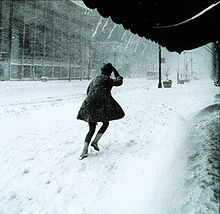February 1969 nor'easter
Category 2 "Significant" ( NOAA: 4.528) | |
 of the nor'easter of the nor'easter | |
| Type | Extratropical cyclone Nor'easter Blizzard Winter storm |
|---|---|
| Formed | February 8, 1969 |
| Duration | February 10, 1969 |
| Lowest pressure | 970 mb (28.64 inHg) |
| Fatalities | 94 fatalities |
| Areas affected | Mid-Atlantic and New England |
The February 1969 nor'easter was a severe
Synoptic history
An
The primary low dissipated, and the secondary low continued to intensify as it moved northeastward from the
Impact

The storm produced paralyzing snowfall from New Jersey through most of New England. Forecasts severely underestimated the duration of the storm, often predicting just a chance of snow.[3] The highest totals—often exceeding 42 in (110 cm)—were reported in the Bangor, Maine, area; Lewiston, Maine, topping 32 in (81 cm). Lesser accumulations up to 20 in (51 cm)—occurred in areas south to western Connecticut, Massachusetts, southern Vermont, northern Rhode Island, and eastern New Hampshire.[1] Lighter snowfall extended as far south as central Virginia, and as far west as Indiana.[4] The snow was accompanied by high winds, in some areas reaching 45 mph (72 km/h). Heavy snow and gale warnings were declared across the region. Tides along the coast ran 2 to 3 ft (0.61 to 0.91 m) above normal during the storm.[5]
New York City was struck particularly hard by the storm. Central Park reported 15 inches (38 cm) of snow, and John F. Kennedy International Airport reported 20 inches (51 cm).[3] It is estimated that 42 people perished, and several hundred more people were injured. The storm disrupted the city for days, and forced schools to close.[6] Streets throughout Queens became impassable; mail service, buses, taxis, delivery vehicles, and trash collection were all disrupted.[7] Thousands of motorists became trapped on the New York State Thruway. A snow emergency was issued in the city, and the Long Island Rail Road suspended all service at the time. The snowstorm left approximately 6,000 travelers stranded at Kennedy Airport. They slept on chairs and floors.[5] Over 1,000 vehicles were stalled or abandoned on the Tappan Zee Bridge; most of these were removed within a day.[8]
Overall, at least 94 deaths were attributed to the storm.[9] Throughout the region, the lack of delivery trucks also led to a shortage of food staples such as milk and bread.[10]
Aftermath
Following the storm, then-mayor
The storm also had an economic impact. The
See also
- Climate of the United States
- List of NESIS storms
References
- Specific
- ^ a b c d e Kocin and Uccellini, p. 450
- ^ NOAA Central Library Data Imaging Project (February 11, 1969). "Daily Weather Maps for February 11, 1969". National Oceanic and Atmospheric Administration. Retrieved January 8, 2010.
- ^ The New York Daily News. Archived from the originalon December 30, 2010. Retrieved January 8, 2010.
- ^ "February 8-10, 1969 snowfall map". National Climatic Data Center. Retrieved January 8, 2010. [dead link]
- ^ a b "East Blanketed by Snow Storm". The Daytona Beach Morning Journal. Associated Press. February 9, 1969. Retrieved January 8, 2010.
- The New York Daily News. Retrieved January 8, 2010.[dead link]
- ^ a b Swewll Chan (February 10, 2009). "Remembering a Snowstorm That Paralyzed the City". The New York Times City Room Blog. Retrieved January 8, 2010.
- ^ "Northeast Paralyzed by Quickie Snowstorm". The Daytona Beach Morning Journal. Associated Press. February 11, 1969. Retrieved January 10, 2010.
- The Tri-City Herald. Associated Press. February 11, 1969. Retrieved January 10, 2010.[permanent dead link]
- ^ "Northeast Begins Digging Out Of Massive Snowstorm". The Rome News-Tribune. Associated Press. February 11, 1969. Retrieved January 8, 2010.
- ^ Waugh, p. 88
- ^ ""My Heart Is as Black as Yours": White Backlash, Racial Identity, and Italian American Stereotypes in New York City's 1969 Mayoral Campaign". Retrieved 2012-09-17.
- ^ "NYSE, Amex boards closed by snowstorm". The Montreal Gazette. Associated Press. February 10, 1969. Retrieved January 8, 2010.
- General
- Paul J. Kocin and Louis W. Uccellini (2004). Northeast Snowstorms. ISBN 1-878220-64-0.
- William L. Waugh (2000). Living with hazards, dealing with disasters: an introduction to emergency management. M.E. Sharpe. ISBN 0-7656-0196-6.
